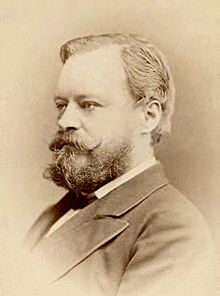Harry Seeley facts for kids
Quick facts for kids
Harry Seeley
|
|
|---|---|
 |
|
| Born | 18 February 1839 London, UK
|
| Died | 8 January 1909 (aged 69) Kensington, London, UK
|
| Nationality | British |
| Awards | Lyell Medal (1885) |
| Scientific career | |
| Fields | Paleontology |
Harry Govier Seeley (born February 18, 1839 – died January 8, 1909) was a British paleontologist. Paleontologists are scientists who study fossils to learn about ancient life on Earth. Seeley is best known for his important discovery about how to group dinosaurs.
Early Life and Studies
Harry Seeley was born in London in 1839. From a young age, he showed a strong interest in science. He attended lectures by famous scientists like Thomas Henry Huxley. He also worked in the library of the British Museum, where he was encouraged to study geology. Geology is the study of Earth's physical structure and substances.
In 1859, Seeley began studying at Sidney Sussex College, Cambridge. He worked as an assistant at the Woodwardian Museum. There, he helped organize and study the museum's collection of fossils. He also started doing his own research on local rocks and fossils.
Even though he never officially earned a degree, Seeley became a respected expert. He turned down jobs at big institutions like the British Museum to work on his own research. Later in his career, he became a professor of geology at several colleges, including King's College London.
Discovering Dinosaur Groups
Harry Seeley made a huge discovery about dinosaurs in 1888. He figured out that dinosaurs could be divided into two main groups. He based this on the shape of their hip bones.
He named these two groups:
- Saurischia: These were the "lizard-hipped" dinosaurs. Their hip bones were shaped like those of modern lizards. This group includes giant long-necked dinosaurs like Brontosaurus and meat-eaters like Tyrannosaurus rex.
- Ornithischia: These were the "bird-hipped" dinosaurs. Their hip bones looked more like those of birds. This group includes plant-eaters like Triceratops and Stegosaurus.
Before Seeley, scientists had different ways of grouping dinosaurs. But his method was so good that it is still used today! It helped scientists understand how different dinosaurs were related. Interestingly, we now know that birds actually evolved from the "lizard-hipped" Saurischia, not the "bird-hipped" Ornithischia, even though the hip shapes are similar.
Seeley also studied pterosaurs, which were flying reptiles that lived at the same time as dinosaurs. In his book Dragons of the Air (1901), he described pterosaurs as active, warm-blooded fliers, not slow, cold-blooded gliders as some thought. He was right about this!
For his important work on reptiles and dinosaurs, Harry Seeley was chosen as a Fellow of the Royal Society in 1879. This is a very high honor for scientists in Britain.


